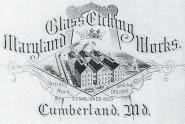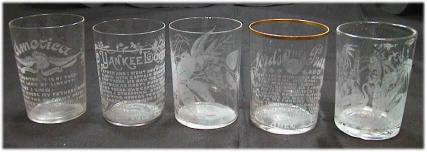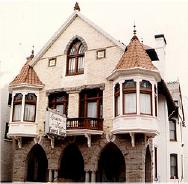National Depression Glass Association
Preserving America's Glass Manufacturing Heritage
Cumberland Glass
Glass Factories in or near Cumberland, Maryland
Maryland Glass Etching Works
George Truog (1861-1932) founded the Maryland Glass Etching
Works of Cumberland, Md. in 1893 after arriving from the Seneca
Glass Factory in Ohio. He had worked in Cumberland previously, at
“The Cumberland” Glass Works. His company was in the
glass decorating  business which used acid to
surface etch glass. The factory was on N. Centre street where
Buchanan Lumber company was located (now occupied by TWR
Communications). George was very artistic and his office and
factory portrayed his characteristics with a rock garden, fountain
and fish pond outside as well as an inside fountain and aquarium.
This grandiose atmosphere was an indication of a business doing
very well. He had been born in Italy, and spent his younger years
in Switzerland.
business which used acid to
surface etch glass. The factory was on N. Centre street where
Buchanan Lumber company was located (now occupied by TWR
Communications). George was very artistic and his office and
factory portrayed his characteristics with a rock garden, fountain
and fish pond outside as well as an inside fountain and aquarium.
This grandiose atmosphere was an indication of a business doing
very well. He had been born in Italy, and spent his younger years
in Switzerland.
His business was decorating the outside of tumblers, pitchers,
vases, and lemonade sets, among other things, with words, flowers,
animals, or other designs. Early methods of inscribing or
decorating glassware included embossing, engraving, sandblasting,
acid etching, imprinting by stamp, and hand painting. Embossing
required an expensive mold, while cutting and engraving did not
allow ease of making letters. Stamping with color pigment could be
rubbed off, hand painting was time consuming, and pyroglazing with
enamel had not been developed yet. Although some painting had been
done on glass, it was not stable. George Truog's acid etching was
there to stay. He was able to be superior to his competition he
would advertise that his etching was guaranteed to not come off. He
would advertise that etched glassware was merely a sideline with
all other factories, but was his specialty because etched glassware
was all he made at his factory. He was able to compete with foreign
trade in Bohemia because of his excellent designs. Bohemia was the
world center for decorated glass. His wares were sent everywhere in
the Western hemisphere. His method was to have the design engraved
in a metal plate. A resist, normally bee's wax, was coated on the
plate. The excess wax was removed from the high points of the
plate, which was the desired design. A tissue was then used to
transfer the wax design to the glassware. When the tissue was
removed, the wax stayed on the glassware, leaving the desired
design with no  protective wax. The
glassware was then exposed to acid, which attacked the unprotected
glass. When the etching was deep enough, the glassware was removed
from the acid, and the wax and acid were washed off, leaving only
the desired design. Click on the photo at left to see a larger
image.
protective wax. The
glassware was then exposed to acid, which attacked the unprotected
glass. When the etching was deep enough, the glassware was removed
from the acid, and the wax and acid were washed off, leaving only
the desired design. Click on the photo at left to see a larger
image.
In the early years, he used sales agents like Fred Seeman of St. Louis, MO, and William Snyder of NYC. Later, he sent out his own advertising. This advertising was done by George, printed from steel engravings, all designed and engraved on steel by himself. In 1905, he sent out complimentary cards containing a picture of his daughter, Rita, with the slogan "My Papa's Compliments and mine, too". The cards also contained George's elegant signature. George also advertised in various glass trade journals.
Many of his customers were distillers and brewers, although he also did The Lord's Prayer, America, and a lot of other patriotic slogans. He did popular sayings and flower or animal designs. An article in the Pottery and Glassware Reporter indicates the product line included glassware, blown and pressed tumblers, stemware, bottles, table sets, and lamp chimneys.
Many of the items produced, which George had a personal hand in, would contain the initials "GT" or "G Truog" or "George Truog". The "GT" would sometimes be in a leaf or a word tail on the right side. Sometimes the initials would stand alone below the etching. Sometimes the G would be over top of the T. The full last name was mostly on larger things like vases or pitchers.
The blanks for these items were most likely obtained from "The Cumberland" glass factory in the early years, which was a few blocks away on N. Mechanic St. As "The Cumberland" changed to National Glass Co. and then Wellington, George became associated with Potomac Glass Co., which also was very close to his factory. With George's help, Potomac carried a line of acid etched glassware. George obtained design patents, which were assigned to the Potomac Glass Co. like design patent 44,043, a flower design on a drinking vessel, issued April 10, 1913. There are three pages of etched designs in the Potomac Glass Co. catalog, but the designs are different than those offered by the Maryland Glass Etching Works.
While George Truog was doing well with his own business at the
turn of the century, he undertook  building one of the finest homes in
Cumberland, shown in the photo at right. It is of Swiss or Italian
design and is located at 230 Baltimore Ave. It reportedly cost
about $50,000 at the time. The building was used as a funeral home
for the past 60 years. With a downswing of his business, the huge
cost of the grandiose house, and a marital court defeat, George
lost his factory and his home in 1909 to the courts. George
continued to make etched items, either by himself or with just a
few helpers, in one room shops, for the next 20 years. By 1918, he
was confined to a wheel chair. George was living in a one room
apartment on Holland Street.
building one of the finest homes in
Cumberland, shown in the photo at right. It is of Swiss or Italian
design and is located at 230 Baltimore Ave. It reportedly cost
about $50,000 at the time. The building was used as a funeral home
for the past 60 years. With a downswing of his business, the huge
cost of the grandiose house, and a marital court defeat, George
lost his factory and his home in 1909 to the courts. George
continued to make etched items, either by himself or with just a
few helpers, in one room shops, for the next 20 years. By 1918, he
was confined to a wheel chair. George was living in a one room
apartment on Holland Street.
The last few years, (1927-1930) George had a shop at the Bennett Transfer building with 8 or 10 girls doing the work. This was his final effort in trying to regain his past business stature. Unfortunately, the marketplace for etched glassware had changed. With prohibition, there no longer was a demand from distillers and brewers. The demand for Victorian type decorated tumblers had waned, and the desire to develop another thriving business was defeated, even though the product was still top grade. When George could not keep his business going, he gave up and went to Wash. DC, where he eventually died. George had donated his 5 foot tall body to the University of Maryland.
George Truog's overall downfall in life was probably caused by his lavish living including the house that he built. For about 15 years, George Truog was able to really enjoy life. His business was producing what was probably the best quality product of its time, and he was apparently making good money. But by 1908, his customers either found alternative approaches to having their glassware decorated, or they found a cheaper source to get adequate goods. In any case, the superiority of the market share of the Maryland Glass Etching Works diminished, and so did the life of a great artistic man.